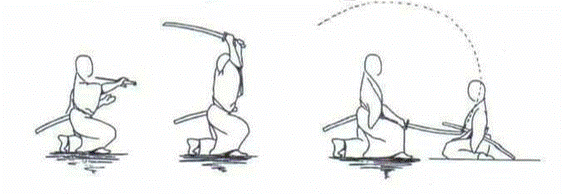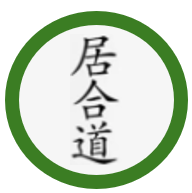01. IPPON ME 一本目
MAE 前
Front
Detecting the harmful intention of the person in front of you, forestall it by using the sword tip to cut their temple in a horizontal action and then bring the sword downwards from above the head in a vertical action.
a] Sit in Seiza and face the front. Gently take hold of the sword with both hands, releasing it slightly frome the mouth of the Saya. Raise up your hips while drawing the sword ensuring the blade remains pointing upwards. When extending the sword keep your left hand at the mouth of the sword sheath pulling it backwards ensuring that the left little finger is in contact with the belt. Make sure that the edge of the blade is facing up. Applying strength to the tips of your toes, turn the sword into a horizontal position just before the blade comes out of the sheath. Extend your hips, put your right foot forward and aim a cut at your opponent's right temple. The sword should finish in a horizontal position.

b] Move your left knee forwards to your right heel in a straight line. At the same time bring the mouth of the sheath back to the navel position and swiftly move the sword above the head with a feeling of thrusting behind the left ear (1). Use your left hand to grip the hilt and as you move the right foot forward, cut down the centerline (2).
(1) In the Furikaburi position with the sword above the head, ensure the Kissaki is not below horizontal.
(2) Upon finishing the cut, the left fist should be in front of the navel and the Kissaki should be just below horizontal.

c] Release your left hand from the hilt and place it against the left hip over the Obi where the Saya is thrust through it. Rotate the edge of the sword so that the right palm inclines upwards. Begin lifting the sword diagonally upwards to the right until your shoulder height. Bend your arm at the elbow so that the hand and sword come close to your right temple. While standing up, shed the blood off by swinging the sword downwards in a 45 degrees angle (on the Kesa line (1) i.e. the line of a monk's stole; the diagonal line across the chest which one flap of the jacket makes) . After shedding the blood off make ready to do Iai Goshi (2).
(1) Chiburi performed on the Kesa line should have a similar feeling to shaking water off an umbrella. At the end of the Chiburi, the right hand should be the same height as the left and positioned to the right front diagonal. The Kissaki should be 45 degrees pointing down and slightly to the inside of the right hand. Ensure the edge of the blade is kept at 45 degrees throughout the Chiburi action.
(2) Iai Goshi is a demonstration of Zan shin (awareness). The knees should be slightly bent and the hips lowered.

d] While executing Iai Goshi make sure both knees are slightly bent. Bring the rear foot up in line with your front foot and then move your right foot back. Take hold of the Koiguchi with your left hand and perform Noto. When the right hand brings the sword into contact with the left, the contact point should be the Tsubamoto (closest point to the Tsuba) . While sheathing the sword your left middle finger should hold the Koiguchi and your left thumb and forefinger should support the back ridge of the sword close to the Tsuba. Extend your right elbow to the right diagonal front and let the tip of the sword point towards your left waist. Put the tip point of the sword into the Koiguchi by sliding and moving both hands in opposite directions. Ensure your left hand controls the sheath. Bring the rear knee down to touch the floor at the same time as the Noto is completed. When you finish sheathing the sword, place your left thumb on the sword guard. The sword guard should be located in front of your navel. Keep the sword in a natural horizontal position.

e] As you stand up bring your rear foot forwards in line with your front foot. Release your right hand from the Tsuka and assume Taito Shisei. Return to your original starting position taking three steps back beginning with the left foot.
● Is the sword taken into Furikaburi with a feeling of thrusting to behind the left ear?
● Is the tip of the sword above the horizontal position when in Furikaburi?
● Is the sword brought down without hesitation during Kirioroshi?
● Is the tip of the sword slightly below horizontal at the end of Kirioroshi?
● Is the shape and form of chiburi correct?
● Is Noto performed correctly?
